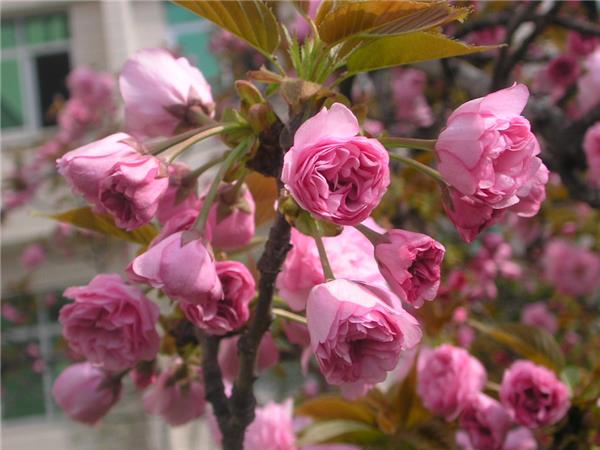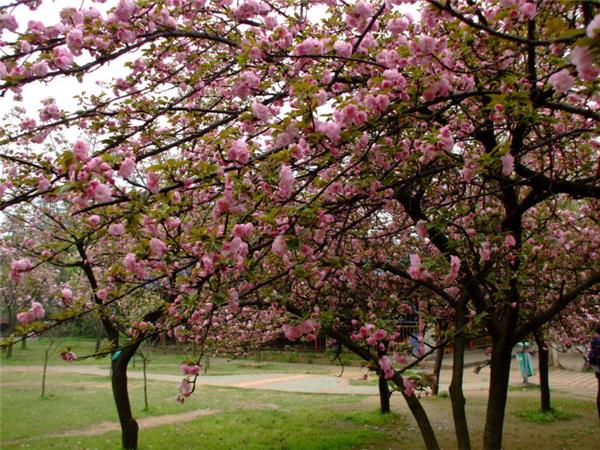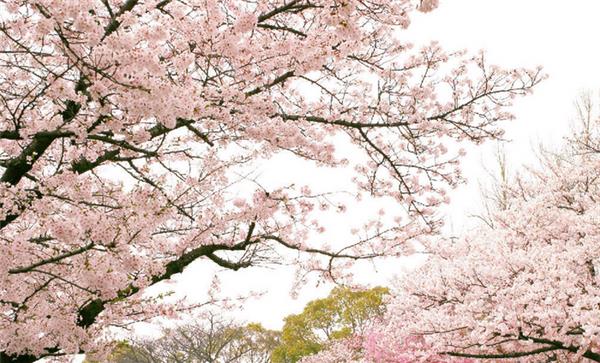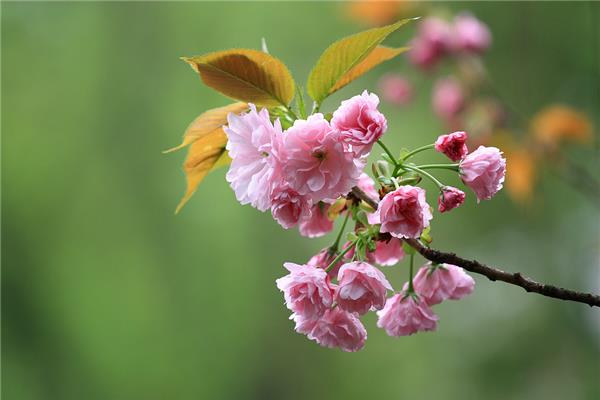Planting and maintenance techniques of Japanese evening cherry how to grow Japanese late cherry
Japanese evening cherry usually blooms in late April, blooming and withering at the same time, and it is the best time to take branches for the next generation of cutting in its full bloom.

1. Morphological characteristics of Japanese evening cherry
Trees, up to 10 meters high. Dry bark grayish, rough; branchlets stout and spreading. Hairless. The leaves are often Obovate. The leaf tip is 5-15 cm long and 3-8 cm wide, the leaf tip is acuminate, showing a long tail, the leaf margin is serrated single or doubly serrated, the tooth tip has a long awn, the back of the leaf is light green, glabrous; the upper part of the petiole has a pair of glands, the petiole is 1-2.5 cm long; the new leaves are glabrous and slightly reddish brown. Flowers large and fragrant, single or double, often pendulous, pink or nearly white; 1-5 arranged in corymbose, bracteoles leaflike, glabrous; peduncle short, 2-4 cm long, sometimes without peduncle. Pedicel 1.5-2 cm long, all glabrous; Calyx tube short, glabrous; petal tip concave; long flowering, open in mid-late April, fruit ovate, black when ripe, shiny.

II. Planting and maintenance of Japanese evening cherry
Cuttings treatment: remove the leaves inserted into vermiculite before insertion and keep the upper leaves. The cuttings were quickly dipped in 1000ppm naphthylacetic acid. That is, insert 2 to 3 cm at the base of the cuttings into 1000 ppm naphthalene acetic acid solution, then immediately take out the cuttings and dip them in.
Planting time: can be carried out from April to July, the experimental records are as follows: from the above table, we can see that the survival rate of cherry blossom is the highest, so the plant is in the peak period of physiological activity and is easy to root. It was planted on April 28 and did not slow down after transplanting on June 28. 0.5 cm new buds sprouted 5 days later, and the trees bloomed after 4 years of culture.
Planting and planting: the location of planting should be where there is plenty of sunshine; because cherry blossoms are all shallow-rooted trees, the soil should be fertile and shelter from the wind; the most suitable topography is the place with gentle slope and lake pond. Expanded vermiculite was used as matrix to maintain pH 6.2. The temperature of vermiculite seedling bed at night is 2 ℃ to 3 ℃ higher than that of soil bed, while the temperature at noon is 1 ℃ to 2 ℃ lower than that of soil bed, indicating that the temperature difference between day and night of vermiculite seedling bed is small, the accumulated temperature is large, and the heat preservation effect is good, which is beneficial to root growth. In production, granular vermiculite is the best, which has good permeability and is conducive to rooting. On the other hand, the powdered vermiculite is sticky and has poor permeability. When raising seedlings, vermiculite should not be mixed with soil, otherwise the roots will rot easily.
Shaping and pruning: big trees can grow naturally without pruning, so as not to affect their growth. However, overdense and weak branches should be cut off to improve canopy ventilation and increase light. Cut off the branches of diseases and insects as soon as possible. When the crown expands too far and bald branches appear in the lower part, it is necessary to retract and change the head in time. Several strong buds in the lower part gradually form an advantage instead, and continue to grow in the following spring to form a new trunk; so repeatedly year after year, an umbrella crown is naturally formed. Usually pay attention to cut off dead branches, over-dense branches, disease and insect branches, cross branches and so on, in order to enhance the ornamental effect.

III. Pest control of Japanese evening cherry
The common pests of Japanese evening cherry are: tea wing bug, peach aphid, carrot microtube aphid, apple aphid, Japanese woolly scale, wisteria gray scale, mulberry white shield scale, Korean brown ball scale, yellow diamondback moth, cotton belt roll moth, large bag moth, tea bag moth, stick brown roll moth, brown edge green diamondback moth, double-toothed green diamondback moth, beautiful green diamondback moth, green diamondback moth, Lina diamondback moth, mulberry brown diamondback moth, peach neck longicorn beetle, dance poison moth, small green leafhopper and so on.
Control methods: if it occurs, you can use 3000 times of 3% hypertonic phenoxarb EC to kill tea wing bugs; 2000 times of imidacloprid wettable particles 2000 times to kill peach aphids, carrot microtube aphids and apple yellow aphids; 3000 times of 3% hyperosmotic phenoxyvir EC or 2000 times of 10% imidacloprid wettable particles or 2000 times of 95% paracetamol EC and 20% fast scale EC 1000 times, spray and kill Japanese woolly scale, mulberry white shield scale and Korean brown ball scale. Spray diamondback moth, Plutella xylostella, Plutella xylostella and tea bag moth with 3000 times of 3% hyperosmotic phenoxyvir EC or 1.2 times of tobacco ginseng. Spray green diamondback moth, green neck longicorn beetle with 7000 times of diflubenzuron emulsion and 1000 times of Bt emulsion. The small green leafhopper was sprayed with 1000 times of the wettable granule.

Japanese evening cherry is of high ornamental value, whether it is solitary planting, planting, or cluster planting. Friends who have a courtyard at home can also try to plant it, so that you can enjoy the splendid beauty of cherry blossoms in April and May every year, even without going far away.
Related
- Wuhan Hospital Iron Tree Blooming Result Was Instantly Frightened by the Gardener Master
- Which variety of camellia is the most fragrant and best? Which one do you like best?
- What is the small blue coat, the breeding methods and matters needing attention of the succulent plant
- Dormancy time and maintenance management of succulent plants during dormancy
- Minas succulent how to raise, Minas succulent plant pictures
- What are the varieties of winter succulent plants
- How to raise succulent plants in twelve rolls? let's take a look at some experience of breeding twelve rolls.
- Attention should be paid to water control for succulent plants during dormant period (winter and summer)
- Watering experience of twelve rolls of succulent plants
- Techniques for fertilizing succulent plants. An article will let you know how to fertilize succulent plants.



